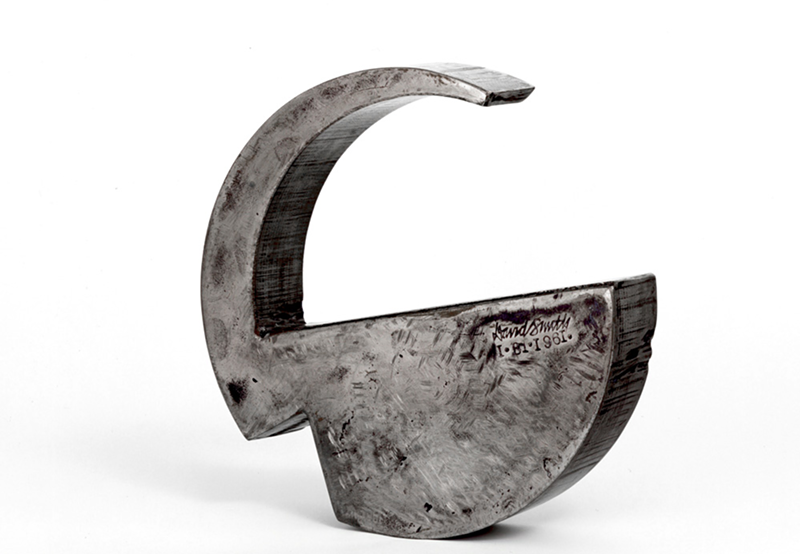Columbus’ Wexner Center for the Arts makes a bold statement in its current retrospective of David Smith’s work: He’s the greatest American sculptor of the 20th century.
If Smith, who died in an auto accident in 1965 at age 59, is ahead of Alexander Calder, Isamu Noguchi or Richard Serra, I’m not sure the general public knows it. At least not in the Midwest, where he was born (Indiana) and raised (Indiana and Ohio) before making a career in New York.
I attended opening day of the Wexner’s impressive retrospective, Cubes and Anarchy, the first thematic exhibition devoted to Smith that was first exhibited at Los Angeles County Museum of Art. I was there from about noon-2 p.m. and there were very few people visiting.
Hopefully, interest has picked up since. Certainly, it should. Smith’s work really deserves to be seen. (The show is up through April 15 and more information is available at www.wexarts.org.) Smith helped set American sculpture free from tradition (and representation) at the very time (mid-20th century) that previously provincial American art was taking center stage.
He achieved two great, lasting breakthroughs, championing the use in sculpture of materials and techniques thought more appropriate to industry than art (welded steel, primarily) and assembling his pieces of metal into sometimes-totemic abstract-expressionist forms and shapes. It added to the vocabulary of abstracted sculpture, moving it from the meditative perfection of Constantin Brancusi’s earlier work to the banged-up-car-part chaos of John Chamberlain. And it still packs a wallop today.
Working with Smith’s estate, this show’s curators have been able not only to bring together some of his best pieces, but also to provide drawings, paintings, sketches and photographs Smith made. This informs the viewer about how and why Smith chose the materials he did.
Having worked as a union steelworker, he was familiar and comfortable with the milieu and materials of industry. He may have even equated steelwork with patriotism — already devoted to art, he helped assemble tanks and locomotives during World War II. But Smith also associated art with progressive social change and saw his sculpture as a statement of solidarity with the working-class. And he also was an avant-gardist.
The geometric shapes and hard angles of Smith’s work look terrific in the Wexner’s Peter Eisenman-designed galleries. As one walks its gentle front-to-back rise, one watches how Smith’s work grew in size as his vision flowered.
His later and larger work takes on increasing importance and pride of place in the show, as he finds his unfailing groove and started to do thematic series. His 1963 “Cubi V,” for instance, features several pieces of buffed stainless steel, each with rectangular planes, balanced atop each other like a juggler in action. It’s a poetic image one wants to hold onto long after visiting the show.
“Circle III,” from 1962, has American Vernacular overtones — a painted-orange circle, with a black center, has two small stems protruding from the top. As an image, it’s not so far removed from the old (pre-ugly-fast-food-franchise) roadside signs one could find for donut or orange-juice stands. As one thinks of that populist connotation, Smith’s connection to Guthrie’s “This Land Is Your Land” comes to mind.
Another lovely, large piece from 1962 is the painted-steel “Primo Piano III,” where the way the pieces — a circle and a column connected by a horizontal bar — rest atop a vertical rod suggests a piano, but also a machine in a factory. One can almost hear the churning.
This show is definitely worth a visit to the Wexner.
A New Way to See Art
NCM Fathom Entertainment, which presents hi-def digital broadcasts of the Metropolitan Opera, L.A. Philharmonic and London’s National Theatre at movie theaters here and elsewhere, ventured into the world of art exhibitions last week, offering a tour of the sold-out Leonardo da Vinci retrospective at London’s National Gallery. Leonardo Live was a smashing success. (The program was not broadcast live, but had a real-time flow since it was filmed during a November preview event.) Besides offering amazingly detailed close-ups of the work, the show’s hosts and art experts presented informed, lively and lucid insight, often seemingly on-the-fly. Several prerecorded segments showed how the exhibition was put together. This left me wanting more international art shows presented on the big screen. You can see what’s next via www.fathomevents.com.
CONTACT STEVEN ROSEN: [email protected]


